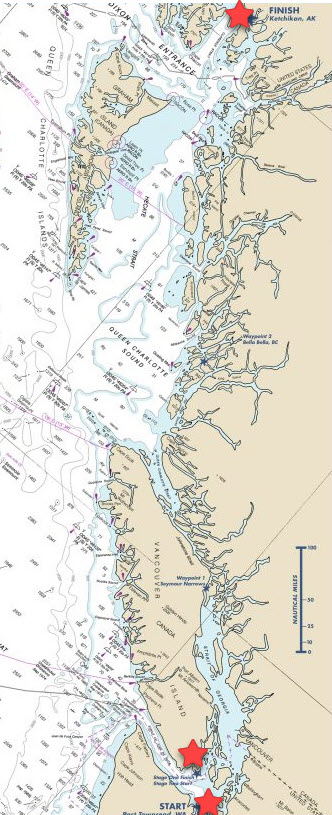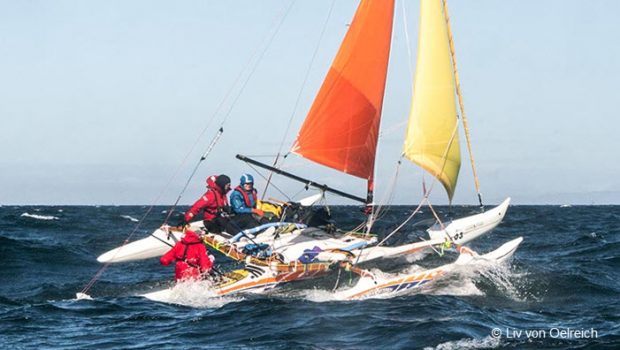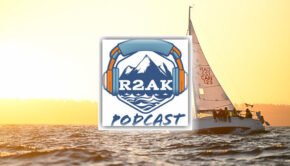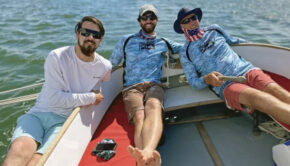R2AK Time Machine Day 11/25
Published on June 26th, 2020
For five years, the Race to Alaska, a 750-mile course from Port Townsend, Washington to Ketchikan, Alaska, proved that journey trumps destination, and while COVID-19 cancelled the 2020 edition, the Organizing Authority is, for 25 days, sharing their fondest memories from the previous races. Enjoy!
Day 11 gives us Team Holopuni, a Polynesian-inspired canoe tackling the waters of the Inside Passage. Not only did they sink their boat in the furious seas of Dixon Entrance, but they also required rescue from the Canadian Coast Guard. Their entire exploit was witnessed by a large magazine writing an exposé on their R2AK attempt, linked here for your enjoyment.
It’s worth noting that while Holopuni required rescue, a Commander of the Canadian Joint Rescue Command commended the team on their level of preparedness, professionalism and excellent responses to the crisis. The crew also went back days later and rescued their boat rather than leave it to break up on coastal shores or a tanker’s bulbous bow.
I think of it as the second cautionary tale in this Time Machine (see Day 7 for the first). They say hindsight is 20/20, but most times it’s closer to 50/50, and thinking from your armchair is a universe and a clean pair of underwear away from making decisions in the middle of a storm. It’s not worth second-guessing their choices, and now you don’t have to make those same mistakes on your race up the Inside Passage.
READ:
2019 Day 12: Holopuni—it’s complicated
Let’s start with the fact that like Vietnam and Amanda Knox’s threesome/murder night, unless we were there we can never know the full truth. We know that at some point before dawn, Team Holopuni flipped the switch from a charismatic mid-pack contender to front runner for Canadian Coast Guard’s customer of the week. That descent into infamy is as true as it is easy to judge, as it skips across the top and rage blames from just knowing the highlights:
• Canoe
• Dixon Entrance
• Mayday
All of that is true, and almost damningly so, and so are at least some of the 2,000 or so words that lie south of here. If you’re like the rest of the world we’ve heard from, you’re somewhere between being ready to pillory both the team and the race for endangering themselves and the lifesaving resources of the coast, and all too ready to forgive and celebrate us all for preserving the honor of freedom and value of valor.
From what we can tell from the inner ward of the R2AK bunker, where you fall on that spectrum of celebration and shame is related to your sum total of experience, fluid ounces of optimism, allegiance to the racers, allegiance to the race, proximity to divorce and/or death of a loved one, and how many layers of internet there are between you and your last close call.
From where we sit, all of you are right—even us, even them.
Optometrists will tell you that your dominant eye is defined by the perspective that doesn’t change when you close the other one. Open both eyes, then look at a far off place, now close one eye, and then the other. Do that until you can figure out your dominant eye and everyone around you thinks you’re crazy. You’re welcome.
Other than a dose of humility, the point of the exercise is this: Depending on what biased eye you look through, Team Holopuni’s campaign that culminated in a Dixon Entrance rescue was either an example of excellent seamanship in a system well designed, a series of fatigue-ridden decisions that reeked of reckless, or somewhere in between.
Squint at this with your non-dominant eye, put yourself in their shoes, what would you do?
What would you do if after a lifetime of sailing, kayaking, and adventure, you found yourself as the 30-foot honor guard of Hawaii’s outrigger scene. Team Holopuni wasn’t just the Aloha state’s outrigger emissary to the R2AK; it was the personal boat of legendary designer Nick Beck who entrusted it to the team as a way for part of him to be in the race he had followed since the beginning.
Imagine you were chosen, entrusted, not just to make a go of it, but to bring honor and connection from KTN to HNL. You found your crew of sailor/adventurers who were hardcore and ready to put it all on the line. “I would never have done this without them. They are exceptionally strong, smart athletes. They know how to take calculated risks—they skied to the South Pole for crissakes…”
With adventure cred to spare, they had nothing to prove, but part of the reason they chose the outrigger was for the adventure. “The obvious thing was to get an F-27 (trimaran). Anybody can do that.” Adventure is at least partially defined by challenge and the lesser taken path, and free range unknowing adventure is why R2AK needs to exist in the first place.
Fast forward to the race and imagine yourself discovering the outrigger reality that your ability to make upwind progress fully loaded was a fraction of what you thought it would be. You might roll 7 knots careless and laughing when the wind is on your stern, but only sail into a small fraction of upwind, and you’ll paddle 2-3 knots beleaguered when you need to churn water human style.
Given the lousy sleep reality of bivy-sack cat naps stolen on trampolines, when facing Dixon Entrance with a good enough forecast, would you gamble on the shortest distance on the map, or the quickest time across the big water given an algebraic best guess of Time x Speed = Distance?
It would be longer and more exposed, but going west of Dundas Island would put the predicted 12 knots of wind on the quarter and set you up for a sleigh-ride crossing that would be faster, safer, and more fun than a side-slipping close reach across the beam seas route to the east that would be shorter in distance but longer in duration.
What would you do?
Guardian Angle vs Guardian Angel—one shift of fate, one shift of the vowel, and things can go from zero to horrible faster than a grammarian’s punctuated curse. One minute Holopuni was a tight program working a solid plan and rocketing along in sustainable rapidity. The next it was half-filled with water as two sets of 7-foot waves broke over the helmsman’s head and swamped the boat.
The swamping was the climax, but the frog boils slowly in situations like these—accidents are caused by the last decision in a chain that starts further back.
The long reaching roots of Team Holopuni’s predicament likely started when they signed up for the race, when they chose their vessel, when they chose to use traditional paddles rather than install pedal drives, when they called their hatch covers ‘good enough’ and not likely to fill with that much water despite the niggling tug at knowing better, and the infinity of other decisions that were the precursors to emergency.
It could have been when they decided that their adventure experience in general translated to the specific prudence required for the R2AK, or even the laser-focused logic required for crossing Dixon Entrance. All of them were good decisions in isolation, but aligned into a single, undeniable chain that brought them to the point when the actual wind doubled the forecasted 15 and sent them sailing downwind under bare poles in every bit of 30 knots.
Then the water became tortured. The crew reported two to three converging sets of breaking waves at heights every bit of seven feet—not the scared reports of people seeing seas for the first time and doubling them with wide eyes, but veteran-reported and coast-guard-confirmed heights of seven feet that were breaking over their canoe and filling it with saltwater.
They had split the difference between too far and not far enough and sailed right into the maelstrom of Celestial Reef where westerly swells and southerly wind stacked up the depths of the inbound Pacific to the 70, then 7 feet of water between them and the bottom.
Weather forecasts are unreliable, especially on the more remote portions of the coast, and the confluence of ‘worse than called for’ collided with the shoal of opportunity that swamped their boat and turned things from scary to irreversible in a matter of minutes.
Having the experience of decades of hard-driving adventure, and heeding the warning of the Coast Guard briefing from a week before, after they collected themselves they knew enough to pull the ripcord before things got desperate.
The boat had enough positive flotation in the amas and watertight compartments in the bow and stern that it would never sink, but the three assessed the situation and hit the button. Vessel swamped but body and soul intact, they called it in early and dodged the worst kind of inevitable.
Mayday.
The hard-swallow choice was based on two undeniables:
• Dewatering couldn’t happen in the sea state that was filling the boat faster than they could pump it out.
• They weren’t getting any warmer.
Imagine yourself there. You’re in your drysuit, half-submerged, not yet hypothermic, but 40 miles from anywhere—what would you do?
If you’re part of the “Suck it up and possibly perish” portion of the internet, you would hang out on the swamped but floating vessel and wait for the time when the weather subsided and you could pump enough to return your boat to viable. There’s also the “Back in my day…” set who deride the call for help, seeing it as a sign of weakness of the racers. They’d say the distress call was an indelible mark of recklessness.
Still others have said their call for help was an outcome of adventure, not the best, but acceptable.
The Holopuni crew were fine on their swamped boat. Sure, the tramps they were waiting on were one inch from the water, with breaking seas dashing them on occasion, but they were snug inside of their expedition-grade drysuits (Mustang BTW, blatant sponsor plug), and called for help early enough that they were all still calm and collected and before they were in mortal danger.
They’d been to the mountain top and across Antarctica—they’d seen some stuff. They knew their edge and called in well in advance of where trouble would start. They were headed towards trouble, but they weren’t there yet, not really. Not for them… but really, and almost.
Aside from the once-a-year Russian military parades, a Mayday is the endpoint on a nonstop trip that hopefully renders you from peril, but definitely takes you from one of us to one of them. Of all their harried adventures up and down mountains, skiing across Antarctica, ultra-marathoning across wherever—until yesterday the Holopuni crew were always the ones offering assistance, never the other way around.
Their shift from rescue supply to demand wasn’t lost on them. Even in the dazed hours post rescue, it stung a little. They were part of ‘those people’ now. Yes, it’s true that they were present and prudent in their final decision to end the race when they still had heat in their body and room to drift—but what about the rest? What are they second guessing in the wake of their last 24 hours?
Ironically, their vessel continued to make steady, slow progress towards Ketchikan—last we checked it was 35 miles out and making a little over a knot in the right direction. At time of writing, teams in Ketchikan had rallied a boat and were heading out with Team Holopuni to salvage it.
There’s an R2AK tendency to find entertainment in bravado; to be entertaining, glib, amusante’ by making light of hardship, and find the through-line of relatable hero for folks both inside the race and observing from the bleachers. This one feels different, at least we hope it does.
This update seeks your attention, seeks your clear-eyed understanding and full-heart compassion in knowing the difference between the half-submerged VHF call that culminates in a successful rescue, and the way that it could have gone. For the six hours between SOS and knowing for sure they were ok, Team Holopuni was in the beyond-the-pale hinterland between happy and sad endings, families and orphans, wedding anniversaries and funerals. In that radio silence, the biggest possible stakes hung in the balance.
Earlier in the week a racer offered his poetic version of R2AK’s crux: “There is a fine line between letting people experience the raw reality of this world, and protecting them from themselves.”
Day 12 may have held the difference between life and death, and maybe not. For people on the sidelines, it was at least a struggle between judgment and compassion. From the harrumphing know betters to the R2AK true-hearts all too willing to forgive and forget, all of us took at least one trip between ‘god damn’ and ‘thank god.’
Somewhere between the choice to remove your hand from the Cheetos/your butt from the couch, and that game-over moment of slipping under a wave for the final time, inside of those horrific bookends of human extremes is the kind of adventure we hope to inspire.
In the words of Team Holopuni: “If we didn’t take risks, why would we be alive?” That, and to take those risks you need to be alive. On Day 12 we raise a glass to what might have been, the brave women and men of the Canadian Coast Guard, and living long enough to fight another day.
WATCH:
Race details – Previous races – Facebook – Instagram
 What was to be in 2020:
What was to be in 2020:
Race to Alaska, now in its 6th year, follows the same general rules which launched this madness. No motor, no support, through wild frontier, navigating by sail or peddle/paddle (but at some point both) the 750 cold water miles from Port Townsend, Washington to Ketchikan, Alaska.
To save people from themselves, and possibly fulfill event insurance coverage requirements, the distance is divided into two stages. Anyone that completes the 40-mile crossing from Port Townsend to Victoria, BC can pass Go and proceed. Those that fail Stage 1 go to R2AK Jail. Their race is done. Here is the 2020 plan:
Stage 1 Race start: June 8 – Port Townsend, Washington
Stage 2 Race start: June 11 – Victoria, BC
There is $10,000 if you finish first, a set of steak knives if you’re second. Cathartic elation if you can simply complete the course. R2AK is a self-supported race with no supply drops and no safety net. Any boat without an engine can enter.
In 2019, there were 48 starters for Stage 1 and 37 finishers. Of those finishers, 35 took on Stage 2 of which 10 were tagged as DNF.
Source: Race to Alaska







 We’ll keep your information safe.
We’ll keep your information safe.